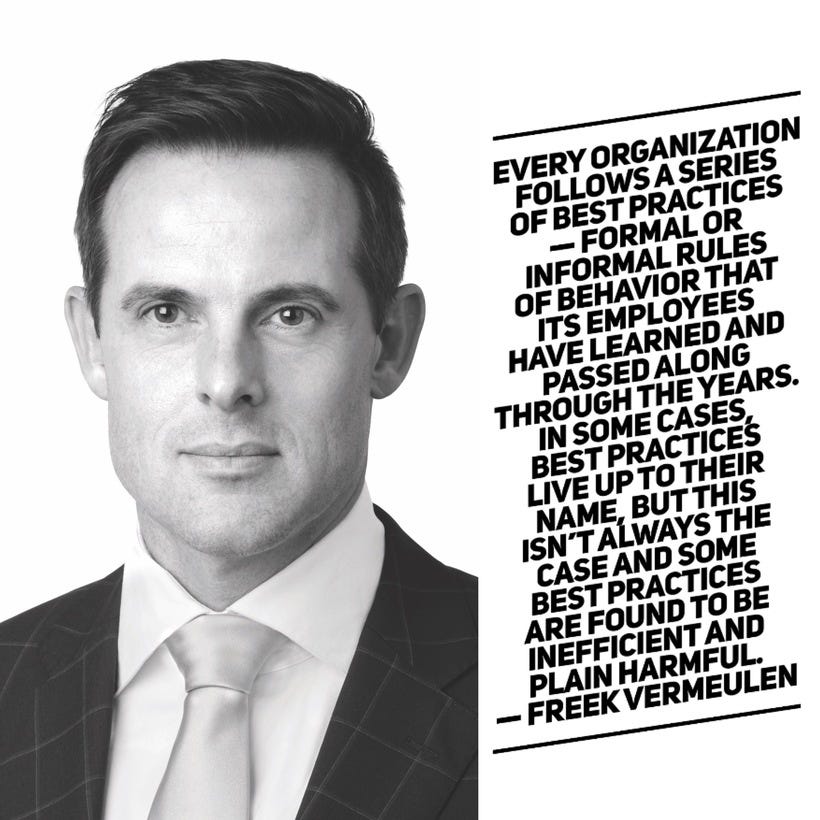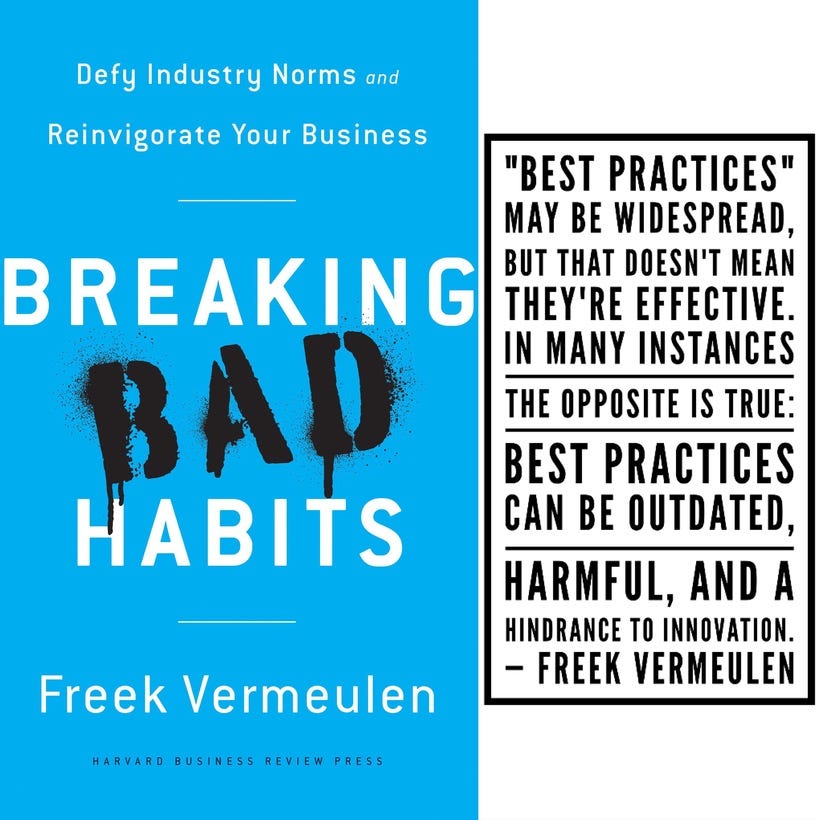
This is Why Your Best Business Practices Are Bad
Freek Vermeulen delivers new book, Breaking Bad Habits, to help identify bad practices and eliminate them from your business.
Organizations in every industry are harming themselves because of so-called “best practices” that have outlived their usefulness.
So exactly how do you defy industry norms and reinvigorate your business?
In Breaking Bad Habits, Freek Vermeulen offers the tools to identify bad practices, eliminate them from your organization, and then move on to create new sources of innovation and growth by out-thinking your competitors.

Vermeulen discusses norm-defying organizations across a range of industries that are in a constant process of renewal — creating new products, processes, and services and creating new opportunities for innovation.
Freek, a professor of strategy and entrepreneurship at London Business School, says we all know that longstanding processes and strategies probably emerged to help businesses operate more competitively and efficiently, but as time goes on they often present limitations that hinder innovation.
These “bad habits” spread like viruses and persist unchecked because managers don’t question their purpose or measure their effectiveness, and are blind to their negative effects, thinking, “That’s just the way we do it here.”

Breaking Bad Habits presents “Ten Commandments of Business Innovation” and other tools to enable thoughtful assessment of timeworn practices to encourage renewal and create new opportunities in any organization.
After reading this book, I was inspired to look into breaking a few bad habits within my own global team at Taboola. I asked Freek what would be the first step he would recommend to kick off this kind of assessment, and he told me that:
“You will have noticed that [in the book] I have listed ‘ask outsiders for suspicions’ (Commandment 6) as one of the pieces of advice. I actually think that is a very good starting point, particularly when it concerns outsiders in the form of new employees, i.e. people who have been with the company for just a few months.
They have gotten to know how the company operates and, without a doubt, will have identified some practices that mystify them. I have noticed that if they speak up and question such habits, they are often rebuffed and told, ‘That’s just the way we do things.’
However, if you and the people in your team can’t do better than that — can’t really explain about your own organization and practices why they are the way they are — there is a good chance that you have identified a bad habit.
In fact, I think organizations should do this systematically: ask new employees after a number of months what the practices are that mystify them and use that as a starting point to question old habits.”
Freek notes that every organization follows a series of best practices — formal or informal rules of behavior that its employees have learned and passed along through the years. In some cases, best practices live up to their name, but this isn’t always the case and some best practices are found to be inefficient and plain harmful.

How do you figure out what these bad practices are and put a stop to them?
Freek states that with rare exceptions, managers do not willingly design and adopt harmful practices — which is great, but if you think about it, is more worrisome. It means that we need to be more consistently proactive and objective in assessing our team’s best practices.
Freek notes that “practices usually have good and bad consequences — as most things in life have — and considering only the good ones while denying the possible existence of bad ones is a recipe for disaster.”
I asked Freek what advice he would give to a manager in a rapidly growing start-up:
“Focus.
The most common mistake I see in new companies — whether fast-growing or not — is that they cannot resist jumping onto new growth opportunities, out of a fear of missing out.
However, the result is usually that they (eventually) end up doing nothing particularly well, and not fulfill their potential. It relates to my advice to ‘take aim at a chunk of the market’ (Commandment 8), rather than try to cover it all.
When you focus on a chunk of the market — a particular set of customers, for example — you will likely find that there are certain things that you can stop doing, which this particular set of customers does not need (which therefore, for them, represent bad practices), which should enable you to do better on other dimensions.”

Founders, executives, and managers alike would all benefit to take a deep dive into this book. It will help you objectively challenge your current best practices, and ensure you’re set up for strategic success in the long run.
Whether you’re just launching your company, are five years into your start-up, or 30 years into a structured corporation, this book is a wake up call that will reshape and recharge your strategies.
In my interview with Vermeulen, he gave solid advice for someone launching a company and setting up best practices for the first time:
“It is often a good idea to work towards establishing some form of best practices. They represent routines that prevent us from having to reinvent the wheel all the time; in fact, they are the way an organization learns.
However, my first piece of advice would be to be careful with ‘benchmarking’, that is, replicating these ‘best practices’ from others in the industry. That is because sometimes these best practices represent represent outdated routines.
By copying others — which we know from research entrants are often inclined to do, for various reasons — you potentially also lose the advantage of being new to the industry, namely to question antiquated habits and use that as a basis for doing something new.
A company like citizenM, for example, explicitly set out with the aim to not emulate the practices of others. And they have certainly done very well as a result of that.
My second piece of advice would be to make sure to not get stuck in those ‘best practices’ though. However useful they are, at some point you need to start questioning them, and it is better to do that at a point in time when they haven’t started to seriously malfunction yet.
I discuss this in the chapter on Change for Change’s Sake: find a way to be proactive in terms of changing. Systematically asking new employees — as discussed with respect to the first question — could help with that.”

Freek notes that the elimination of bad practices should not be a one-off process. They are likely to pop up again, so avoid settling into a routine and growing stale and complacent.
Rather, embrace change for change’s sake — don’t wait for trouble and decline, but make proactive changes to your modus operandi.
Change is a capability; if your organization changes regularly, changing will become easier. Yes, there are costs to change, but change is inevitable. Be varied and selective. Create a climate of innovation, but be ready to cull all but the best ideas.
I found this book to be very informative, insightful, and most importantly — strategically actionable.

Freek enables everyone, from founders to managers to employees, to take action directly by including useful questionnaires throughout the book to use when reflecting on the need for change, measuring the learning behavior of your team, diagnosing where your organization is on the curve between exploitation and exploration, etc.
By strategically using the tools and executing on the action points provided in Breaking Bad Habits, smart managers can learn how to purposefully identify and eradicate bad habits, and turn them into a profitable source of renewal and innovation.
Use this book as an inspiration to defy industry norms and turn your defiances into a source of innovation!

*Disclosure: This post contains affiliate links, meaning, at no additional cost to you, I will earn a small commission if you click through and make a purchase.
*I received this book from Harvard Business Review Press. The opinions I have expressed are my own; I love reading and would not waste my time consuming or recommending something that I didn’t think was excellent. I only endorse books I find personally helpful and believe will be constructive for my strategic community.


